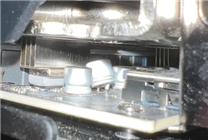Concerns Arise: Capacitor Explosions in RTX 50 Series Graphics Cards
In recent days, the gaming community has been buzzing with alarming reports of capacitor explosions in NVIDIA’s latest RTX 50 series graphics cards. Just days after a user recounted a shocking incident involving the RTX 5090, another user experienced a similar malfunction with the RTX 5070. These rare yet concerning occurrences are capturing significant attention among tech enthusiasts and gamers alike.
What Happened?
According to reports, a user playing "Marvel" experienced a sudden blast from their RTX 5070 graphics card, leading to panic when they discovered a exploded capacitor. This incident mirrors a previous explosion involving the RTX 5090—marking two incidents within a remarkably short timeframe. Such failures are atypical, but their recurrence has left many questioning the reliability of these advanced graphics units.
Location of the Failures
Investigations into the incidents indicate that the exploded capacitors were situated near the I/O ports of the graphics cards, specifically next to the choke and inductor components. These capacitors are integral to the Power Management Integrated Circuit (PMIC) responsible for regulating the voltage and current supplied to the GPU. It raises concerns that the capacitors may be struggling to handle the power demands placed upon them during intense gaming sessions.
Manufacturer Responsibility
While NVIDIA provides the GPU chips and memory modules, it’s essential to understand that the responsibility for component quality largely remains with the manufacturers who assemble the cards. Reports suggest that these capacitor explosions might stem from the use of inadequate or low-quality components rather than any fundamental flaw in NVIDIA’s designs. As we delve deeper into the issue, it’s crucial to determine if these incidents point to a broader issue within specific models or manufacturers.
Are the Cards Still Usable?
Interestingly, in the case of the RTX 5070, despite the capacitor explosion, the graphics card continues to function effectively. This indicates that the damage was contained and did not compromise the integrity of the PCB (Printed Circuit Board). The user in question has already filed for a return and exchange, underscoring the importance of warranty and customer support for affected users.
Community Reaction
The gaming community has responded with a mix of concern, curiosity, and some skepticism. Many are sharing their own experiences to shed light on whether these incidents are isolated or part of a larger trend impacting the RTX 50 series. Discussions around quality control and product reliability are taking center stage, with experts weighing in on the potential implications for future graphics card designs.
Conclusion: Moving Forward
As we move forward, it’s crucial for manufacturers and consumers alike to keep a close eye on these developments. While the RTX 50 series delivers impressive performance capabilities, these incidents highlight the importance of component quality and reliability. NVIDIA and other manufacturers must ensure rigorous testing and quality assurance protocols to prevent future occurrences.
For now, gamers are advised to remain vigilant, monitor their hardware closely, and advocate for transparency regarding the quality of components used in their graphics cards. As the landscape of gaming technology continues to evolve, staying informed and prepared will be key for enthusiasts and professionals alike.








